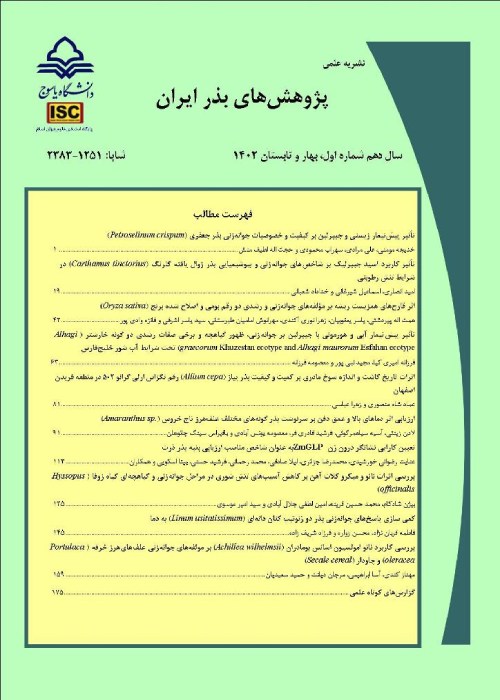Efficiency of Chemical and Mechanical Priming in Breaking Seed Dormancy and Germination Traits of Malva (Malva neglcta)
Author(s):
Article Type:
Research/Original Article (دارای رتبه معتبر)
Abstract:
Extended abstract
Introduction
Malva (Malva neglecta) is one of perennial plants of the Malvaceae family. One of the most important mechanisms for survival of the plants is dormancy, rest or distance in germination and growth; in this case, despite favorable conditions for germination, the seed remains at rest for an indefinite period of time. Seed dormancy is a consistent feature in some seeds, especially weed seeds to optimize distribution of germination over time. Seed dormancy has a very important role in ecological management. The cause of the physical dormancy lies in skin cells outside tier structure that is impermeable to water. In physical dormancy, the seed coat is so hard that it does not allow the embryo to grow during germination. The chemical dormancy of the plants seeds is caused by the presence of inhibitor substances in the outer shell of many fruits and seeds and may also be due to an Enamel layer that blocks the exchange of oxygen. It goes without saying that understanding the ecology of weed germination and dormancy can contribute to long-term management. Therefore, this study was conducted to determine the effects of breaking seed dormancy and the impact of chemical and mechanical treatments on the germination of the Mallow seeds.
Materials and Methods
In order to recognize the effects of chemical and mechanical treatments on breaking seed dormancy and some of the most important features of seed germination of Malva, the experiment was conducted based on a completely randomized design with 4 replications at Crop Physiology Lab, Razi University, during 2016. Treatments were distilled water (control), sulfuric acid 98% (for 2, 3 and 4 minutes), potassium nitrate 3% (for 3, 4 and 7 days), hydrogen peroxide 30% (for 2, 3 and 4 minutes) and scarification with sandpaper and prechilling (for 1, 2 and 3 weeks). Germination percentage, germination rate, length and dry weight of hypocotyl, length and dry weight of radicle, seedling total dry weight and vigor index were evaluated. Group comparisons, analysis of variance and comparison of means were run based on LSD at 5% level, using SAS software (version 9.4).
Results
The results showed that the highest and the lowest germination percentage were 82% and 5% in scarification with a chilling for 3 weeks and control treatments, respectively. The results of treatment group comparisons also showed that using scarification with a chilling had the greatest impact on seed dormancy breaking. The most hypocotyl length (34.92 mm), hypocotyl dry weight (2.60 g), seedling dry weight (3.29 g) and seed vigor index (58.13) were observed in scarification with a chilling for 3 weeks. The highest germination rate (5.21 in day), radicle length (34.92 mm) and radicle dry weight (0.85 g) also belonged to sulfuric acid 98% for 2 minutes. It seems that seed dormancy of Malva was a combination of physiological and physical dormancy, because the effectiveness of the treatments evaluated in both metabolic and physical processes brought about the increase in the seed germination percentage.
Conclusion
Out of the treatments examined and given the results of group comparisons, scarification with sandpaper and prechilling had the most effect on breaking Malva’s seed dormancy. As scarification with chilling had the main role in breaking seed dormancy, it could be said that the dormancy is physiological and factors contributing to this dormancy are the embryo, the existence of inhibiting factors or both. The results indicated that the germination of Malva (Malva neglcta) seeds mechanically scratched with scarification increased. Therefore, seed dormancy is due to hard coated seeds. The seed coat is as one physical barrier against growth of embryo or radicle that inhibits absorption of water and gas exchanges.Highlights: 1- Investigating dormancy breaking and germination traits of neglcta species of Malva.
2- Evaluation of efficiency of different chemical and mechanical treatments in the germination traits of Malva
Keywords:
Language:
Persian
Published:
Iranian Journal of Seed Research, Volume:5 Issue: 1, 2018
Pages:
55 to 70
magiran.com/p1900019
دانلود و مطالعه متن این مقاله با یکی از روشهای زیر امکان پذیر است:
اشتراک شخصی
با عضویت و پرداخت آنلاین حق اشتراک یکساله به مبلغ 1,390,000ريال میتوانید 70 عنوان مطلب دانلود کنید!
اشتراک سازمانی
به کتابخانه دانشگاه یا محل کار خود پیشنهاد کنید تا اشتراک سازمانی این پایگاه را برای دسترسی نامحدود همه کاربران به متن مطالب تهیه نمایند!
توجه!
- حق عضویت دریافتی صرف حمایت از نشریات عضو و نگهداری، تکمیل و توسعه مگیران میشود.
- پرداخت حق اشتراک و دانلود مقالات اجازه بازنشر آن در سایر رسانههای چاپی و دیجیتال را به کاربر نمیدهد.
In order to view content subscription is required
Personal subscription
Subscribe magiran.com for 70 € euros via PayPal and download 70 articles during a year.
Organization subscription
Please contact us to subscribe your university or library for unlimited access!


